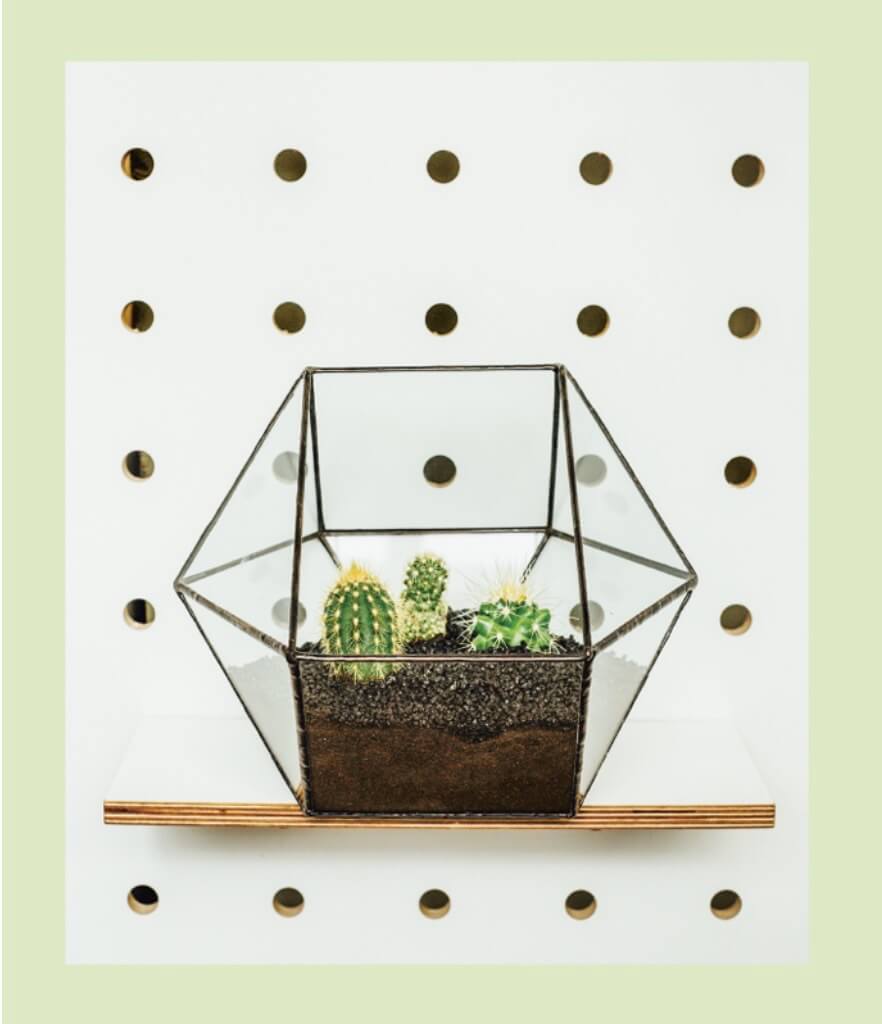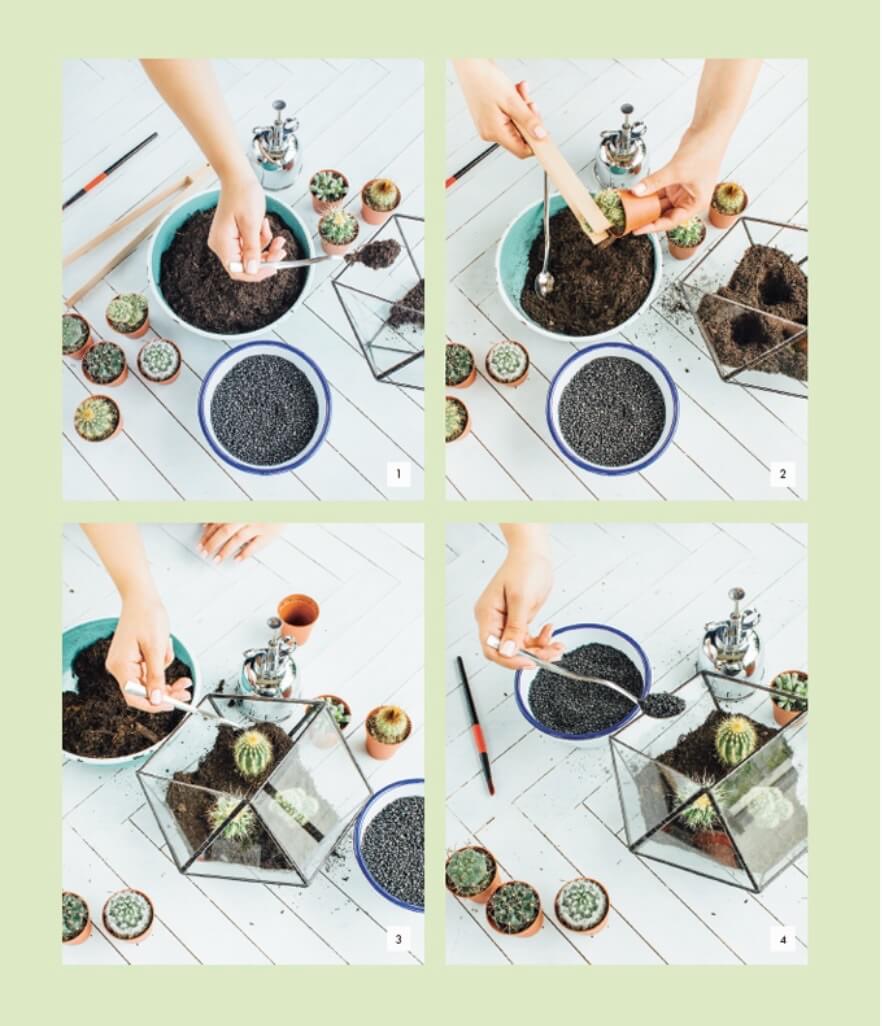[Ebook Việt hoá] Living With Plants: A Guide to Indoor Gardening (2017) - Sophie Lee
[Ebook Việt Hoá] Indoor Gardening (2017): Make an Open Terrarium (Làm Bể Bán Cạn Hở)
- Nguồn: Ebook Living With Plants: A Guide to Indoor Gardening (2017) – Sophie Lee
- Biên tập: Dũng Cá Xinh
- Dịch: Huyền Nguyễn
English
MAKE AN OPEN TERRARIUM

Unlike a closed terrarium, which is completely sealed, an open terrarium is, as the name implies, left open. Desert plants like cacti and succulents are great for this sort of terrarium as they need more oxygen and do not like to be as humid and wet as they would be inside a closed terrarium.
Because open terrariums are not self-sustaining, I recommend lightly spraying the plants once a week with a mister. Please do not be tempted to pour water into your terrarium, as this may cause the plants to rot. Succulents and cacti like bright light, so it’s best to keep your finished terrarium near a window.
At geo-fleur, we love geometric shapes and like to make terrariums in geometric glass containers. You can hunt for a vintage one or buy them in most gift stores or online. Alternatively, be creative with the vessel you use. Try making an open terrarium in an apothecary jar, large antique drinking glass or a fishbowl.
YOU WILL NEED
- cactus potting compost
- clear glass container or terrarium
- activated charcoal
- long-handled teaspoon
- selection of small cacti and/or succulents
- thin kitchen tongs
- aquatic gravel (available at pet shops)
- funnel (optional)
- small paint brush
- 1. Spoon the potting compost into the bottom of the terrarium to a depth of about 5 cm (2 in).
- 2. Sprinkle a little bit of activated charcoal over the top of the compost.
- 3. If you can reach inside the container, use two fingers to make a well for your cactus or succulent to sit in; if you cannot use your fingers, use a long-handled spoon instead. Make sure you do not make the well too deep – you need to leave about 2 cm (¾ in) of soil at the bottom of the well.
- 4. Remove a plant from its pot – make sure you use the tongs to hold the plant if it is a cactus so you do not get spikes in your fingers. Gently squeeze the plastic pot that the plant is in and it should come out easily. If it is pot-bound – when the plant’s roots fill the pot and start to grow out of the drainage holes – and will not come out, tickle the bottom of the pot to release the roots.
- 5. Holding the plant with tongs, angle it into the terrarium and place it into the well. If you find it difficult to hold the plant just using tongs, a little tip is to use your spoon and tongs like a knife and fork. Use the spoon or tongs to compress the soil around the plant to make sure it is nice and secure – you will probably need to spoon some more compost around the plant and compress it to achieve this. Make sure that the plant is not wobbling around.
- 6. Repeat steps 3–5 until all the plants are inside your terrarium. Use the top of your spoon to test if all the plants are secure by doing a wobble test: gently tap the top of the plant or nudge its leaves to see if it moves. If any are not firmly in place, add more compost and compress it around the plant.
- 7. Use the spoon to add a 2–3 cm (¾–1 in) layer of aquatic gravel on top of the compost. Please do not be tempted to add decorative stones instead, as the aquatic gravel helps with drainage. You can use a funnel instead of a spoon if this is easier or if your terrarium is a difficult shape.
- 8. If you get any of the gravel or soil on your plants, use the paint brush to dust off the debris.
Tag your finished #LivingWithPlantsTerrarium
#LivingWithPlantsHowTo @geo_fleur

Tiếng Việt
LÀM MỘT HỒ CẠN MỞ

Không giống như một hồ cạn kín được đóng kín hoàn toàn, một hồ cạn mở, giống như tên gọi, chúng được để mở. Thực vật sa mạc như Xương Rồng và cây mọng nước rất phù hợp với loại hồ cạn này vì chúng cần nhiều oxy hơn và không ưa môi trường ẩm ướt như ở trong hồ cạn kín.
Bởi vì các hồ cạn mở không có khả năng tự dưỡng, tôi khuyên bạn nên phun sương nhẹ cho cây mỗi tuần một lần. Vui lòng không đổ nước vào hồ cạn của bạn, vì điều này có thể làm thối cây. Cây mọng nước và Xương Rồng ưa ánh sáng rực rỡ, vì vậy tốt nhất bạn nên để hồ cạn đã hoàn thiện gần cửa sổ.
Tại Geo-fleur, chúng tôi yêu thích các hộp dạng hình học và thích làm hồ cạn trong các hộp thủy tinh hình học. Bạn có thể tìm mua một chiếc hộp mang nét cổ điển hoặc mua chúng ở hầu hết các cửa hàng quà tặng hoặc mua trực tuyến. Ngoài ra, hãy sáng tạo với bình bạn sử dụng. Hãy thử làm một hồ cạn trong một lọ thuốc bào mòn, một ly uống nước cổ lớn hoặc một chậu cá.
BẠN SẼ CẦN:
- phân trộn bầu Xương Rồng
- hộp thủy tinh trong suốt hoặc hồ cạn
- than hoạt tính
- thìa cà phê cán dài
- các cây Xương Rồng hoặc/ và cây mọng nước nhỏ
- kẹp bếp mỏng
- sỏi thủy sinh (có bán tại cửa hàng thú cưng)
- phễu (tùy chọn)
- chổi sơn nhỏ
- Xúc phân trộn trong bầu xuống đáy hồ cạn đến độ sâu khoảng 5 cm (2 in).
- Rắc một ít than hoạt tính lên trên lớp phân trộn.
- Nếu bạn có thể với vào bên trong hộp thủy tinh, hãy dùng hai ngón tay để tạo thành hố nhỏ để đặt cây Xương Rồng hoặc cây mọng nước của bạn vào, nếu bạn không thể sử dụng ngón tay của mình, hãy sử dụng thìa cán dài để thay thế. Đảm bảo bạn không làm hố quá sâu, bạn cần để lại khoảng 2 cm (¾ in) đất ở đáy hố.
- Lấy cây ra khỏi chậu, nhớ dùng kẹp để giữ cây nếu đó là cây Xương Rồng để không bị gai đâm vào ngón tay. Nhẹ nhàng bóp bầu nhựa chứa cây và bạn sẽ lấy cây ra dễ dàng. Nếu cây được trồng trong chậu, khi rễ cây lấp đầy chậu và bắt đầu mọc ra khỏi các lỗ thoát nước và khó lấy cây ra ngoài, hãy gõ nhẹ và xoa vào đáy chậu để rễ tách ra.
- Giữ cây bằng kẹp, đưa cây vào hồ cạn và đặt vào hố nhỏ. Nếu bạn cảm thấy khó khăn khi cầm cây chỉ bằng kẹp, một mẹo nhỏ là hãy sử dụng thìa và kẹp như dao và nĩa. Dùng thìa hoặc kẹp để nén đất xung quanh cây để đảm bảo đất đẹp và chắc chắn, bạn có thể sẽ cần phủ thêm một ít phân trộn xung quanh cây và nén chặt để cây đứng vững. Đảm bảo rằng cây không bị lung lay.
- Lặp lại các bước 3-5 cho đến khi đã trồng hết tất cả các cây bên trong hồ cạn của bạn. Sử dụng đầu thìa để kiểm tra xem tất cả các cây có chắc chắn không bằng cách thử lắc lư hộp thủy tinh: gõ nhẹ vào đầu cây hoặc dùng tay ấn vào lá để xem nó có di chuyển không. Nếu chỗ nào chưa chắc chắn, hãy đổ thêm phân trộn và nén xung quanh cây.
- Dùng thìa để thêm một lớp sỏi thủy sinh 2-3 cm (¾ – 1 in) lên trên lớp phân trộn. Vui lòng không thêm đá trang trí, vì sỏi thủy sinh giúp thoát nước. Bạn có thể sử dụng phễu thay vì thìa nếu việc này dễ dàng hơn hoặc nếu hồ cạn của bạn có hình dạng khó thực hiện.
- Nếu có dính sỏi hoặc đất trên cây, hãy dùng chổi sơn để quét sạch các mảnh vụn.
Gắn thẻ #LivingWithPlantsTerrarium khi bạn đã hoàn thành
#LivingWithPlantsHowTo @geo_fleur

Xem thêm các phần khác của sách
![[Ebook Việt Hoá] Indoor Gardening (2017): Make an Open Terrarium (Làm Bể Bán Cạn Hở) [Ebook Việt Hoá] Indoor Gardening (2017): Make an Open Terrarium (Làm Bể Bán Cạn Hở)](https://vn1.vdrive.vn/codai.net/2021/05/ebook-indoor-gardening-13-open-tetarrium.jpg)


